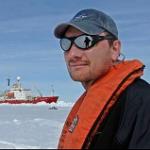Advanced Technology for Persistent, Long-Range, Autonomous Under-Ice Observation
This project advances the national health, prosperity, and welfare by developing and demonstrating a new robotic technology for persistent, autonomous observation of under-ice marine environments over large (>1000 km) spatial scales. The Arctic is undergoing rapid change, with dramatic shifts in the sea ice cover and upper ocean. Monitoring and understanding these changes is critical to improving our ability to predict ongoing change and variability on seasonal to decadal timescales. Current observational capabilities are severely hampered by the logistical challenges of operating in this environment - observations are sparse, infrequent, and expensive to obtain, especially for the under sea ice observations. As a low-cost, easy to deploy platform, the unmanned underwater vehicle developed by this project will be transformative in our capability for effective widespread and continuous monitoring of the Arctic Ocean and its ice cover. Under-ice missions to monitor ice-ocean properties across a retreating ice edge in spring will provide a proof of concept for a unique capability to efficiently address a wide range of scientific questions under the Arctic ice cover that can benefit from measurements over large spatial and temporal scales. This project supports the NSF Big Idea on Navigating the New Arctic. As a future component of an Arctic Observing Network, this innovative technology can provide a critical cog in our ability to effectively monitor the Arctic and inform management of increased Arctic commercial, mineral extraction, and fisheries activities, as well as planning for resilience of Arctic coastal communities.
This project will develop and demonstrate a highly modified autonomous underwater glider (AUG) equipped with a dual-use active sonar for characterizing ice thickness distribution, as well as for real-time terrain-aided navigation. This will enable under-ice observation across extended distances without the need for external navigation aids such as acoustic beacons. The AUG will also encompass an automated mission planner/replanner wherein the vehicle can autonomously adapt its mission plan in response to evolving mission goals and environmental or vehicle state changes, such as data-driven adaptive sampling, changing surfacing locations based on ice drift, or in the event of a component failure impeding vehicle progress and decreasing expected range. Finally, a new variable thrust hybrid propulsion system will be developed for operation in both shallow coastal waters with high currents and deeper waters, enabling efficient transit from coastal to remote science locations, while enabling the vehicle to conduct water column profiling, as well as close-range ice survey. These characteristics will facilitate long-term unattended under-ice observation with reduced cost and logistical requirements.
This award reflects NSF's statutory mission and has been deemed worthy of support through evaluation using the Foundation's intellectual merit and broader impacts review criteria.
This NNA collaboration between Camilli (1839063, WHOI) and Williams (1837646, MIT) will develop and demonstrate a new robotic technology for persistent, autonomous observation of under-ice marine environments over large (>1000 km) spatial scales. This new autonomous vehicle technology will be a highly modified hybrid autonomous underwater glider (AUG) with new, efficient propulsion that can operate effectively on both shallow shelves and deeper waters, autonomous terrain aided navigation without the need for external navigation aids, and both ocean profiling and ice survey capability. 2019 will focus on testing the vehicle platform, including launch and recovery systems and extensive sea trials in shallow coastal Massachusetts waters (including in high current areas). In 2020, a field team of two will travel to Alaska for field testing and deployment site selection. These initial Arctic field trials will be carried out over a one-week period using a small research vessel (R/V Ukpik) on the continental shelf and shelf break between Prudhoe Bay and Utqiaġvik (Barrow) Alaska in August. The following year in 2021, a field team of two will conduct continuous under-ice operations in field trials that will investigate the ice-ocean interactions driving ice retreat over four months in the Chukchi Sea.
Resources
Acoustic Monitoring of Ocean Surface Wave Spectra with Autonomous Underwater Gliders
We present a new, low-cost method for monitoring wave spectra (significant height, period, and direction) using an autonomous underwater glider equipped with a low power scanning sonar. Unlike conventional fixed buoys, this method enables coverage across wide spatial areas, including remote and difficult to access regions, such as the marginal ice zone or areas with extreme sea states. Preliminary results indicate that this process can operate continuously for durations of weeks, with spatial coverage in excess of 1000 km.
Improved Navigation for Long Range Autonomous Underwater Gliders
Autonomous underwater gliders (AUGs) are long range vehicles, capable of traversing basin scale distances. However, AUGs currently lack sufficient navigation accuracy to traverse long distances without periodic surfacing to obtain GPS fixes and constrain the localization drift. We present a method and preliminary results from field trials for improved AUG navigation using a Doppler Velocity Log to dynamically profile water column currents.
Project Outcomes
The overall goal for this project was to develop and demonstrate a new hybrid autonomous underwater glider (AUG) suited for under-ice exploration. This fills a technological void and enables science observations that are not feasible with ice-tethered platforms, ships, or conventional autonomous underwater vehicles (AUVs) or AUGs. This hybrid AUG uses both the traditional AUG bouyancy engine as well as a propellor for locomotion. In order to successfully operate for long periods under ice, this hybrid AUG also carries key autonomy technologies, such as terrain-aided navigation (to geo-locate while under ice where GPS is unavailable), a smart path planner that optimizes the depth band in which it operates to take advantage of water currents, and automated risk-aware mission planning.
The overall goal for this project was to develop and demonstrate a new hybrid autonomous underwater glider (AUG) suited for under-ice exploration. This fills a technological void and enables science observations that are not feasible with ice-tethered platforms, ships, or conventional autonomous underwater vehicles (AUVs) or AUGs. This hybrid AUG uses both the traditional AUG bouyancy engine as well as a propellor for locomotion. In order to successfully operate for long periods under ice, this hybrid AUG also carries key autonomy technologies, such as terrain-aided navigation (to geo-locate while under ice where GPS is unavailable), a smart path planner that optimizes the depth band in which it operates to take advantage of water currents, and automated risk-aware mission planning.
This was envisioned as a three year project, with a 3-4 month long under ice mission planned for year 3 in the Chukchi Sea. However, the planned under ice demonstrations never happened due to the global outbreak of COVID-19.
While the demonstrations never happened, the team was still able to meet many of its technological goals. This report focuses on the efforts of the MIT-based subteam. This subteam was responsible primarily for the smart path planner and automated risk-aware mission planning aspects. Additionally, this subteam was largely responsible for the compute and control infrastructure in the hybrid AUG beyond what is included in the stock AUG.



